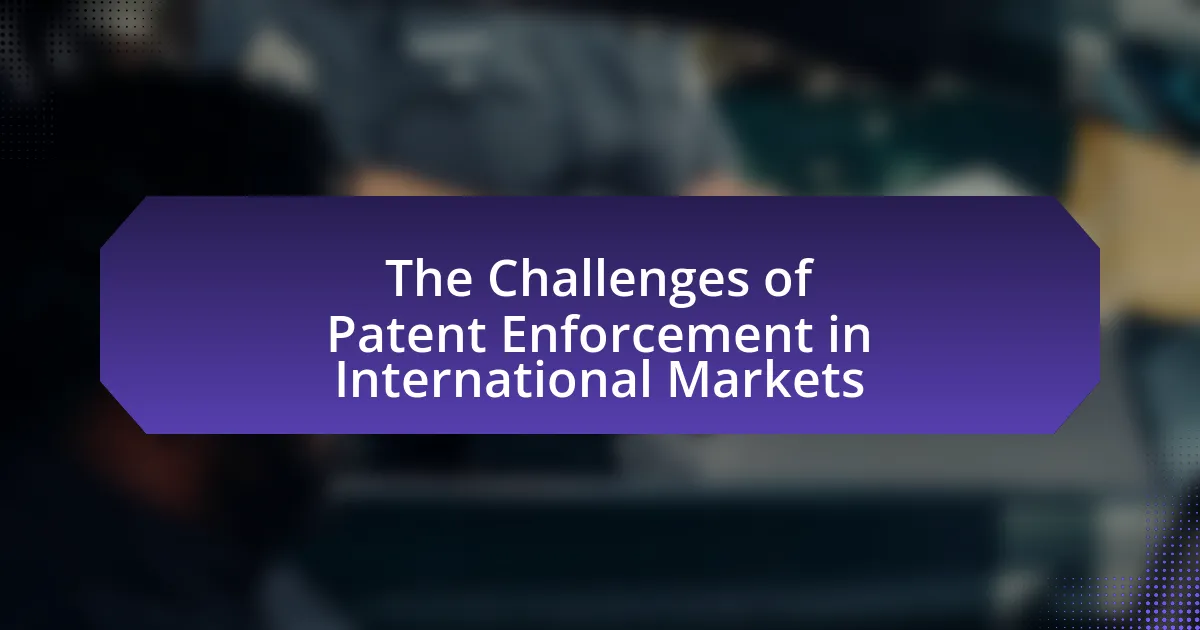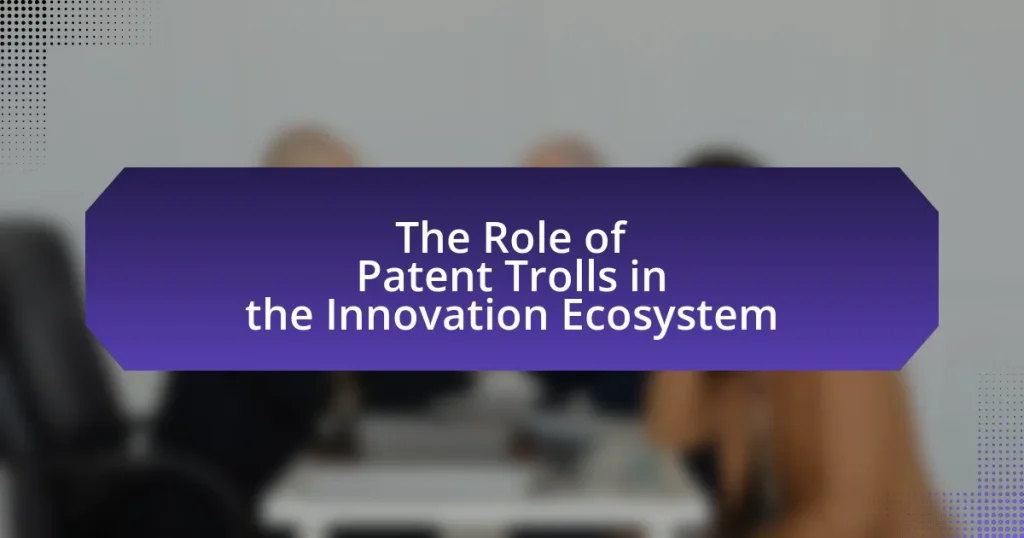The article examines the challenges of patent enforcement in international markets, highlighting key issues such as differing legal frameworks, varying levels of intellectual property protection, and jurisdictional complexities. It discusses how these factors impact enforcement strategies, with a focus on the variations in patent laws across countries and the influence of cultural perceptions on compliance. Additionally, the article addresses the implications of these challenges for businesses, including increased legal costs and potential financial losses, while offering best practices for navigating the complexities of international patent enforcement. The role of international treaties and technology in enhancing enforcement efforts is also explored, along with common pitfalls to avoid in the process.
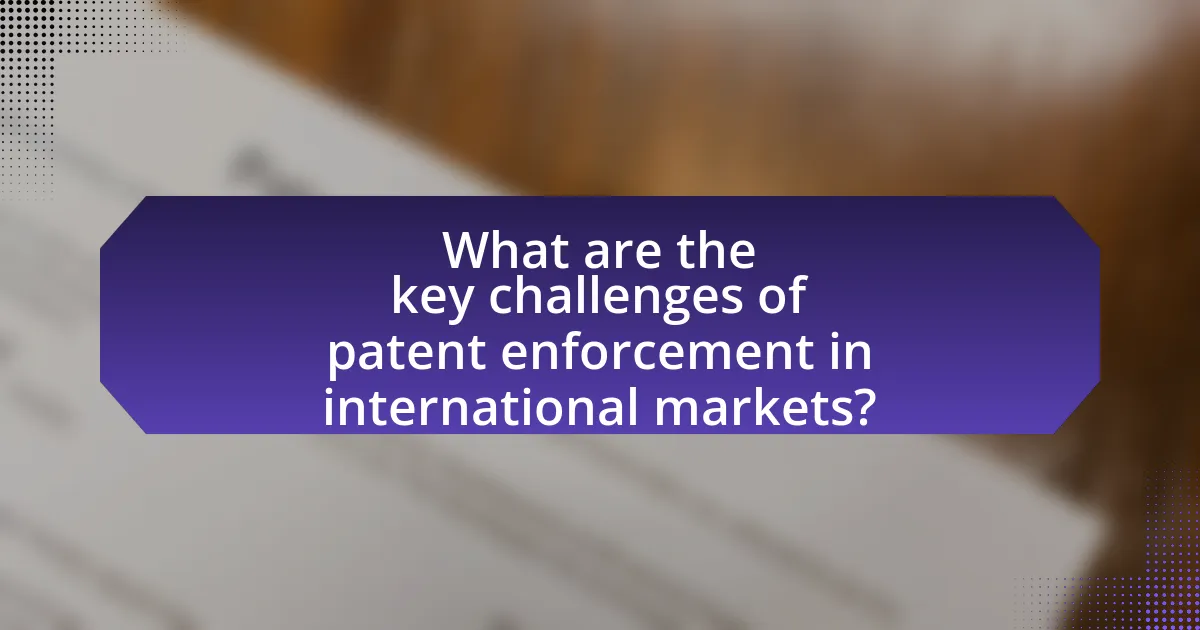
What are the key challenges of patent enforcement in international markets?
The key challenges of patent enforcement in international markets include differing legal frameworks, varying levels of intellectual property protection, and difficulties in jurisdiction. Different countries have unique patent laws and enforcement mechanisms, which can lead to inconsistencies in how patents are recognized and enforced. For instance, while some countries may have robust patent protection, others may lack effective enforcement mechanisms, making it challenging for patent holders to protect their rights. Additionally, jurisdictional issues arise when patent infringement occurs across borders, complicating legal proceedings and enforcement actions. These challenges are further exacerbated by the global nature of commerce, where products and technologies can easily cross international boundaries, making it difficult to monitor and enforce patent rights effectively.
How do differing legal systems impact patent enforcement?
Differing legal systems significantly impact patent enforcement by creating variations in the interpretation, scope, and enforcement of patent rights. For instance, in the United States, the “first to invent” principle historically governed patent rights, while many other countries have adopted a “first to file” system, leading to discrepancies in patent ownership and validity. This divergence can result in challenges for patent holders seeking to enforce their rights internationally, as they may face different standards of proof, varying lengths of litigation, and distinct remedies available in each jurisdiction. Additionally, countries with weaker intellectual property protections may not provide adequate enforcement mechanisms, further complicating the ability of patent owners to defend their rights effectively.
What are the variations in patent laws across countries?
Patent laws vary significantly across countries, impacting the scope, duration, and enforcement of patents. For instance, the United States grants a patent term of 20 years from the filing date, while countries in the European Union also adhere to this duration but have specific regulations regarding patentability criteria, such as the exclusion of software patents in certain contexts. Additionally, some countries, like India, have unique provisions that allow for compulsory licensing under specific conditions, which contrasts with the more rigid enforcement seen in jurisdictions like Japan, where patent rights are strictly upheld. These differences can lead to challenges in international markets, as companies must navigate diverse legal landscapes to protect their intellectual property effectively.
How do these variations affect enforcement strategies?
Variations in patent laws and enforcement mechanisms across different jurisdictions significantly affect enforcement strategies. These differences can lead to inconsistencies in how patents are protected, making it challenging for patent holders to enforce their rights effectively. For instance, a patent that is valid in one country may not be recognized in another, resulting in a fragmented approach to enforcement. Additionally, variations in legal frameworks, such as the length of patent protection and the criteria for infringement, require patent holders to tailor their enforcement strategies to each specific market. This often involves increased legal costs and the need for local legal expertise to navigate diverse regulatory environments, as evidenced by the World Intellectual Property Organization’s reports highlighting the complexities of international patent enforcement.
What role does cultural perception play in patent enforcement?
Cultural perception significantly influences patent enforcement by shaping attitudes toward intellectual property rights and compliance with legal frameworks. In countries where innovation is highly valued, such as the United States and Germany, there is generally a strong respect for patents, leading to rigorous enforcement and adherence to patent laws. Conversely, in cultures where communal sharing of knowledge is prioritized, such as in some developing nations, there may be a tendency to view patents as barriers to access, resulting in lower compliance and enforcement rates. For instance, a study by the World Intellectual Property Organization (WIPO) highlights that cultural attitudes towards ownership and innovation directly affect the effectiveness of patent systems, demonstrating that countries with a strong cultural emphasis on individualism tend to have more robust patent enforcement mechanisms.
How do cultural attitudes towards intellectual property influence enforcement?
Cultural attitudes towards intellectual property significantly influence enforcement by shaping the perceived value and legitimacy of intellectual property rights within different societies. For instance, in cultures that prioritize communal sharing and collaboration, such as some collectivist societies, there may be less emphasis on strict enforcement of intellectual property laws, leading to higher rates of infringement. Conversely, in individualistic cultures that value innovation and personal ownership, there tends to be stronger support for enforcement mechanisms, as seen in countries like the United States, where robust legal frameworks and public awareness campaigns promote respect for intellectual property. This divergence in cultural attitudes can result in inconsistent enforcement practices across international markets, complicating the ability of patent holders to protect their rights effectively.
What are the implications of these attitudes for international businesses?
The implications of attitudes toward patent enforcement for international businesses include increased operational risks and potential financial losses. Businesses may face challenges in protecting their intellectual property across different jurisdictions, leading to a higher likelihood of infringement and counterfeiting. For instance, a study by the International Chamber of Commerce indicates that global trade in counterfeit goods could reach $4.2 trillion by 2022, highlighting the financial impact on companies that fail to secure their patents effectively. Additionally, varying enforcement standards can create uncertainty, making it difficult for businesses to strategize their market entry and investment decisions. This uncertainty can deter innovation and reduce competitive advantage in international markets.
How does the complexity of international treaties affect patent enforcement?
The complexity of international treaties significantly complicates patent enforcement by creating varying legal standards and obligations across jurisdictions. Different countries may interpret treaty provisions differently, leading to inconsistencies in patent protection and enforcement mechanisms. For instance, the Agreement on Trade-Related Aspects of Intellectual Property Rights (TRIPS) sets minimum standards for patent protection, but individual countries can implement these standards in diverse ways, resulting in challenges for patent holders seeking to enforce their rights globally. This complexity can lead to increased litigation costs and uncertainty, as patent owners must navigate a patchwork of legal systems and potentially conflicting laws.
What are the major international treaties governing patents?
The major international treaties governing patents are the Paris Convention for the Protection of Industrial Property and the Agreement on Trade-Related Aspects of Intellectual Property Rights (TRIPS). The Paris Convention, established in 1883, provides a framework for patent protection and establishes the principle of national treatment, ensuring that foreign patent holders receive the same protection as domestic ones. The TRIPS Agreement, which came into force in 1995, sets minimum standards for patent protection and enforcement among World Trade Organization (WTO) member countries, requiring them to adhere to specific criteria regarding the duration and scope of patent rights. These treaties are foundational in shaping global patent law and facilitating international trade by providing a consistent legal framework for patent protection.
How do these treaties facilitate or hinder enforcement efforts?
Treaties can both facilitate and hinder enforcement efforts in international patent law. They facilitate enforcement by establishing standardized legal frameworks that promote cooperation among countries, enabling easier cross-border litigation and recognition of patent rights. For example, the Agreement on Trade-Related Aspects of Intellectual Property Rights (TRIPS) sets minimum standards for patent protection, which helps harmonize laws and improve enforcement mechanisms globally. However, treaties can also hinder enforcement when they create complex compliance requirements or when countries lack the resources to implement them effectively. For instance, some developing nations may struggle to meet TRIPS obligations, leading to inconsistent enforcement and potential exploitation of patent rights.
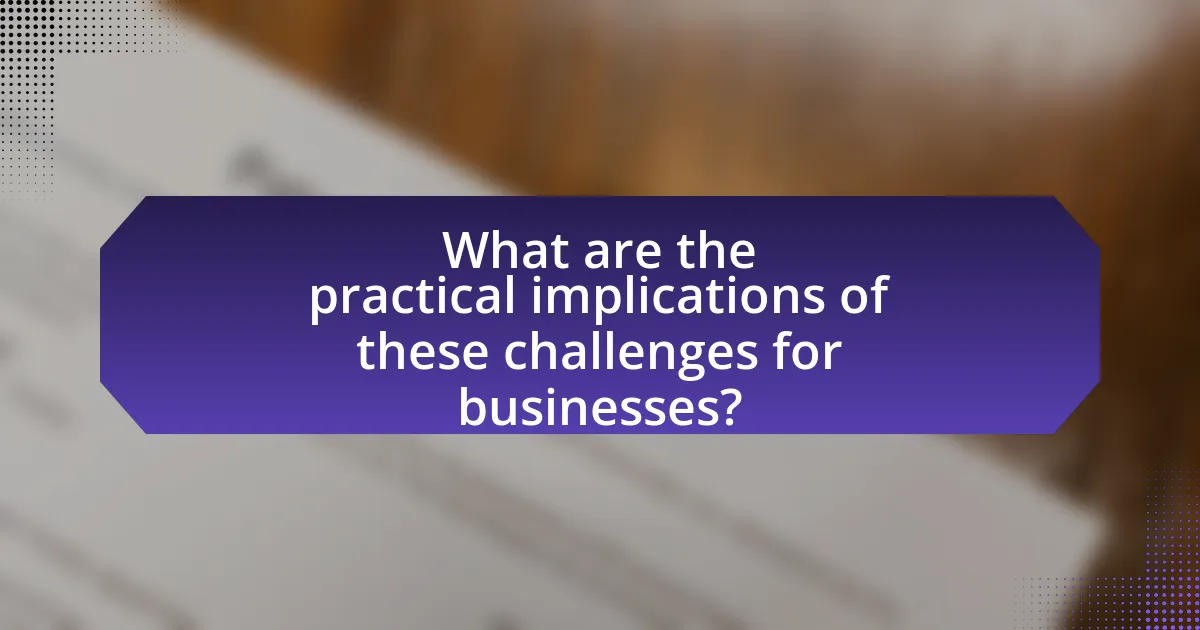
What are the practical implications of these challenges for businesses?
The practical implications of challenges in patent enforcement in international markets for businesses include increased legal costs, potential loss of competitive advantage, and difficulties in market entry. Businesses face heightened expenses due to the need for extensive legal resources to navigate varying patent laws across jurisdictions. For instance, a study by the World Intellectual Property Organization indicates that companies can spend up to 20% of their revenue on intellectual property protection in regions with weak enforcement. Additionally, the risk of patent infringement can deter innovation, as firms may hesitate to invest in new technologies without robust protection. This environment can lead to a significant competitive disadvantage, particularly for small and medium enterprises that lack the resources to engage in protracted legal battles.
How can businesses navigate the complexities of international patent enforcement?
Businesses can navigate the complexities of international patent enforcement by conducting thorough research on the patent laws and enforcement mechanisms in each target market. Understanding the specific legal frameworks, such as the Paris Convention and the Agreement on Trade-Related Aspects of Intellectual Property Rights (TRIPS), is crucial for compliance and effective enforcement. Additionally, businesses should engage local legal experts to assist in navigating jurisdictional differences and to develop tailored strategies for patent protection. For instance, a study by the World Intellectual Property Organization (WIPO) highlights that companies with localized legal support are more successful in enforcing patents across borders, as they can better address regional nuances and legal challenges.
What strategies can companies employ to protect their patents abroad?
Companies can employ several strategies to protect their patents abroad, including filing for international patents through the Patent Cooperation Treaty (PCT), conducting thorough market research to identify potential infringement risks, and establishing strong legal agreements with local partners. The PCT allows companies to seek patent protection in multiple countries simultaneously, streamlining the process and reducing costs. Additionally, understanding local patent laws and enforcement mechanisms is crucial, as these can vary significantly between jurisdictions. Companies can also engage local legal experts to navigate these complexities effectively. Furthermore, proactive monitoring of the market for potential infringements and taking swift legal action when necessary can deter unauthorized use of patented technologies. These strategies collectively enhance a company’s ability to safeguard its intellectual property in international markets.
How can businesses assess the risk of patent infringement in foreign markets?
Businesses can assess the risk of patent infringement in foreign markets by conducting thorough patent landscape analyses and engaging local legal expertise. Patent landscape analyses involve reviewing existing patents in the target market to identify potential conflicts, while local legal experts can provide insights into the specific patent laws and enforcement practices of that jurisdiction. For instance, a study by the World Intellectual Property Organization (WIPO) indicates that understanding local patent regulations significantly reduces the likelihood of infringement. Additionally, businesses should monitor competitors’ activities and patent filings to stay informed about emerging risks.
What are the financial implications of patent enforcement challenges?
Patent enforcement challenges can lead to significant financial implications for companies, including increased litigation costs, potential loss of revenue, and diminished market share. Companies facing enforcement challenges often incur substantial legal fees, which can range from hundreds of thousands to millions of dollars, depending on the complexity of the case. For instance, a study by the National Bureau of Economic Research found that patent litigation can cost defendants an average of $1.5 million in legal expenses. Additionally, if a company is unable to enforce its patents effectively, it may lose exclusive rights to its innovations, resulting in reduced sales and profits as competitors enter the market. This loss of exclusivity can lead to a decrease in stock value, as investors may perceive the company as less competitive. Furthermore, the uncertainty surrounding patent enforcement can deter investment in research and development, as companies may be less willing to invest in innovation if they fear their patents cannot be effectively protected.
How do enforcement challenges impact the cost of doing business internationally?
Enforcement challenges significantly increase the cost of doing business internationally by creating legal uncertainties and potential liabilities. Companies face higher expenses related to compliance, legal fees, and risk management when navigating different jurisdictions with varying enforcement mechanisms. For instance, a study by the World Intellectual Property Organization (WIPO) indicates that businesses operating in countries with weak patent enforcement may incur costs up to 30% higher due to the need for additional legal protections and strategies to safeguard their intellectual property. This financial burden can deter investment and innovation, ultimately affecting a company’s competitiveness in the global market.
What are the potential losses from patent infringement in international markets?
Potential losses from patent infringement in international markets include significant financial damages, loss of market share, and reputational harm. Financial damages can arise from lost sales, estimated to be in the billions annually; for instance, a 2019 report by the U.S. Chamber of Commerce indicated that patent infringement costs U.S. companies approximately $29 billion each year. Loss of market share occurs when infringing products capture consumer interest, undermining the original patent holder’s competitive position. Reputational harm can lead to diminished trust among consumers and investors, further impacting a company’s long-term viability. These factors collectively illustrate the severe implications of patent infringement on businesses operating in global markets.
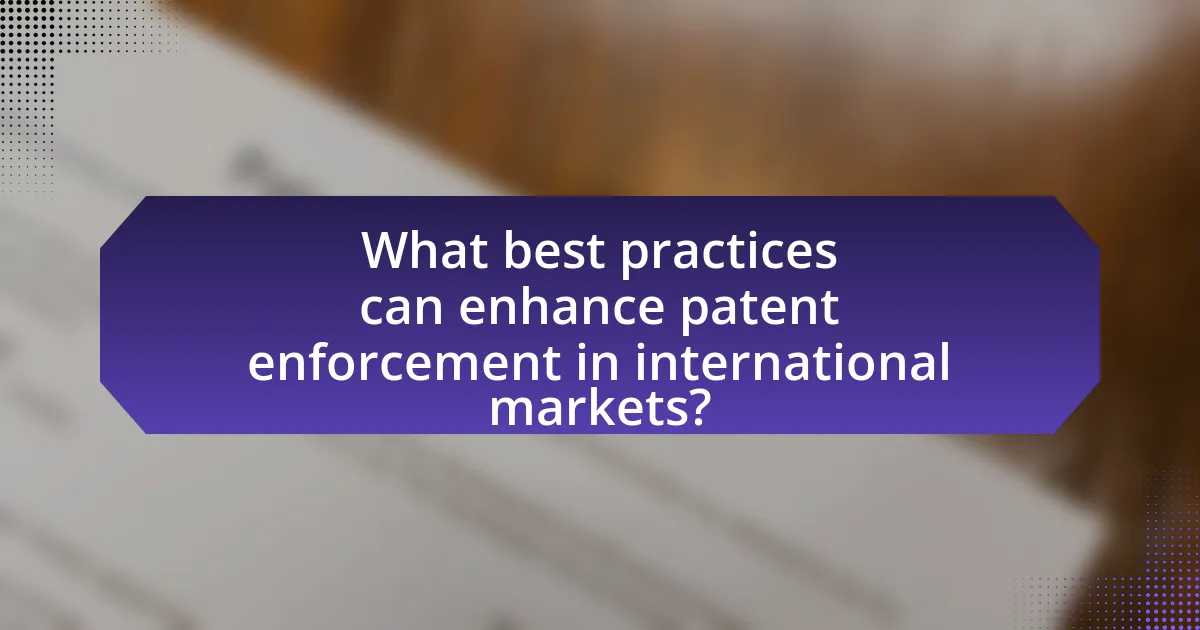
What best practices can enhance patent enforcement in international markets?
Best practices that can enhance patent enforcement in international markets include conducting thorough market research, establishing strong local partnerships, and utilizing international treaties effectively. Conducting market research allows companies to understand the specific legal frameworks and enforcement mechanisms in different jurisdictions, which is crucial for tailoring enforcement strategies. Establishing strong local partnerships with legal experts and enforcement agencies can facilitate quicker and more effective actions against infringement. Additionally, leveraging international treaties, such as the Patent Cooperation Treaty (PCT) and the Agreement on Trade-Related Aspects of Intellectual Property Rights (TRIPS), provides a framework for consistent enforcement across borders, ensuring that patent rights are recognized and upheld in multiple countries. These practices collectively improve the likelihood of successful patent enforcement in diverse international markets.
How can companies build a robust patent enforcement strategy?
Companies can build a robust patent enforcement strategy by conducting thorough patent audits, establishing clear enforcement policies, and leveraging legal expertise. Conducting patent audits helps identify and prioritize valuable patents, ensuring that companies focus on the most critical assets. Establishing clear enforcement policies provides a framework for responding to infringements, including guidelines for litigation and alternative dispute resolution. Leveraging legal expertise, such as hiring specialized patent attorneys, enhances the ability to navigate complex international patent laws and regulations. According to a study by the World Intellectual Property Organization, effective patent enforcement can significantly increase a company’s competitive advantage in international markets.
What role does legal counsel play in developing enforcement strategies?
Legal counsel plays a critical role in developing enforcement strategies by providing expertise in intellectual property law and ensuring compliance with legal standards. They analyze patent rights, assess potential infringements, and advise on the best legal actions to take, which may include litigation or negotiation. Legal counsel also helps in drafting and reviewing contracts to safeguard patent rights and can represent clients in international jurisdictions, navigating complex legal frameworks. Their involvement is essential for creating effective strategies that align with both legal requirements and business objectives, thereby enhancing the likelihood of successful enforcement in international markets.
How can companies leverage technology to improve enforcement efforts?
Companies can leverage technology to improve enforcement efforts by utilizing advanced data analytics and artificial intelligence to monitor and detect patent infringements more effectively. These technologies enable real-time tracking of product usage and market activities, allowing companies to identify potential violations swiftly. For instance, AI algorithms can analyze vast amounts of data from various sources, including online marketplaces and social media, to pinpoint unauthorized use of patented technologies. Additionally, blockchain technology can enhance transparency and traceability in patent ownership, making it easier to establish rights and enforce them across different jurisdictions. According to a report by the World Intellectual Property Organization, the integration of such technologies can significantly reduce the time and resources spent on enforcement actions, thereby increasing overall compliance and protection of intellectual property rights.
What are the common pitfalls to avoid in international patent enforcement?
Common pitfalls to avoid in international patent enforcement include failing to understand local laws, neglecting to conduct thorough prior art searches, and underestimating the importance of proper documentation. Understanding local laws is crucial because patent rights and enforcement mechanisms vary significantly across jurisdictions, which can lead to ineffective strategies if not considered. Conducting thorough prior art searches is essential to ensure that the patent is valid and enforceable; overlooking this can result in costly litigation. Proper documentation, including maintaining records of patent use and infringement, is vital for substantiating claims in court. These pitfalls can severely hinder the effectiveness of patent enforcement efforts in international markets.
What mistakes do companies often make when enforcing patents abroad?
Companies often make critical mistakes when enforcing patents abroad, including failing to understand local laws and regulations. This lack of knowledge can lead to ineffective enforcement strategies, as patent laws vary significantly between countries. For instance, a company may assume that a patent granted in one jurisdiction will have the same protections in another, which is often not the case. Additionally, companies frequently underestimate the importance of local partnerships and legal representation, which can hinder their ability to navigate foreign legal systems effectively. According to a study by the World Intellectual Property Organization, many companies that do not engage local experts face higher risks of patent infringement and lower chances of successful litigation.
How can companies learn from past enforcement failures?
Companies can learn from past enforcement failures by conducting thorough post-mortem analyses of unsuccessful cases to identify specific weaknesses in their strategies. This involves reviewing the legal frameworks, understanding the jurisdictional challenges, and analyzing the effectiveness of their evidence and arguments. For instance, a study by the European Patent Office highlighted that companies often fail to adapt their enforcement strategies to local legal environments, leading to ineffective outcomes. By systematically documenting these failures and the reasons behind them, companies can refine their approaches, enhance their understanding of international patent laws, and improve their future enforcement efforts.
